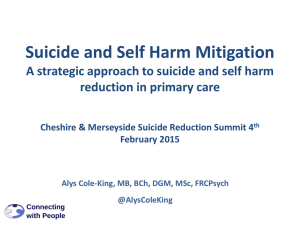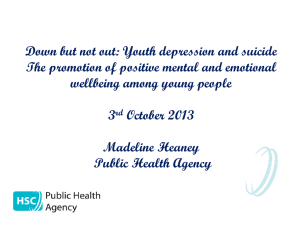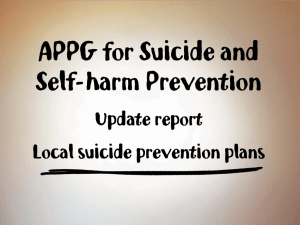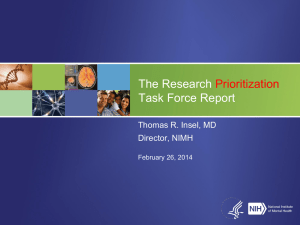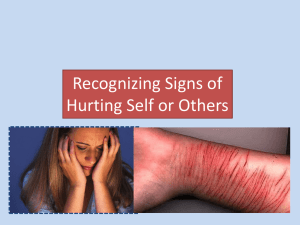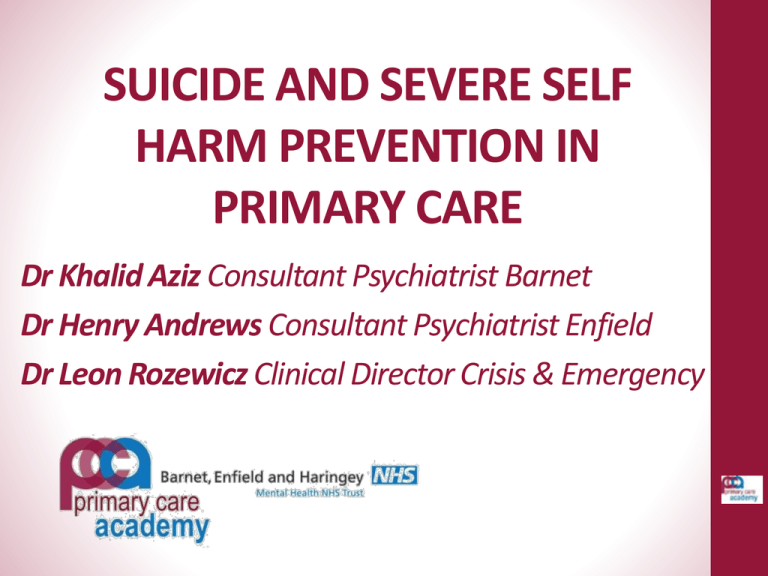
SUICIDE AND SEVERE SELF
HARM PREVENTION IN
PRIMARY CARE
Dr Khalid Aziz Consultant Psychiatrist Barnet
Dr Henry Andrews Consultant Psychiatrist Enfield
Dr Leon Rozewicz Clinical Director Crisis & Emergency
Resilience?
• Everyone experiences stress and difficult circumstances
during their life.
• Most people can handle these tough times and may even be
able to make something good from a difficult situation.
• Resilience is the ability to bounce back after experiencing
trauma or stress, to adapt to changing circumstances and
respond positively to difficult situations.
• It is the ability to learn and grow through the positive and
the negative experiences of life, turning potentially
traumatic experiences into constructive ones.
• Being resilient involves engaging with friends and family for
support, and using coping strategies and problem-solving
skills effectively to work through difficulties.
Contributory Factors - Individual Well-Being
• Self Image: sense of self, including self-esteem secure
identity, ability to cope, and mental health and wellbeing
• Behavior: social skills including life skills,
communication, flexibility, and caring
• Spirit: sense of purpose, including motivation, purpose
in life, spirituality, beliefs, and meaning
• Heart: emotional stability, including emotional skills,
humor, and empathy
• Mind: problem solving skills, including planning,
problem-solving, help-seeking, and critical and creativethinking.
• Body: physical health, physical energy, and physical
capacity
A Person’s Reaction to Life Events - Main Factors
1. Individual Health and Well-Being - Sense of self, social
skills, sense of purpose, emotional stability, problem-solving
skills, and physical health.
2. Pre-Disposing or Individual Factors - Genes, gender and
gender identity, personality, ethnicity/culture, socioeconomic background, and social/geographic inclusion or
isolation.
3. Life History and Experience - Family history and context,
previous physical and mental health, exposure to trauma, past
social and cultural experiences, and history of coping.
4. Social and Community Support - Support and
understanding from family, friends, local doctor, local
community, school, level of connectedness, safe and secure
support environments, and availability of sensitive
professionals/carers and mental health practitioners.
Myth vs. Fact
Myth: People who talk about suicide don’t die
by suicide.
Fact: Many people who die by suicide have
given definite warnings to family and friends
of their intentions. Always take any comment
about suicide seriously.
Myth: Suicide happens without warning.
Fact: Most suicidal people give many clues and
warning signs regarding their suicidal
intention.
Myth vs. Fact
Myth: People who are suicidal are fully intent on dying.
Fact: Most suicidal people are undecided about living or
dying – which is called suicidal ambivalence. A part of
them wants to live; however, death seems like the only
way out of their pain and suffering. They may allow
themselves to “gamble with death,” leaving it up to other
to save them.
Myth: Males are more likely to be suicidal.
Fact: Men die by suicide more often than women.
However, women attempt suicide three times more often
than men.
Myth vs. Fact
Myth: Asking a depressed person about suicide will push
him/her to kill themselves..
Fact: Studies have shown that patients with depression
have these ideas and talking about them does not
increase the risk of them taking their own life.
Myth: Improvement following a suicide attempt or crisis
means that the risk is over.
Fact: Most suicides occur within days or weeks of
“improvement” when the individual has the energy and
motivation to actually follow through with his/her
suicidal thoughts.
Myth vs. Fact
Myth: Once a person attempts suicide the pain and shame
will keep them from trying again.
Fact: The most common psychiatric illness that ends in
suicide is major depression, a recurring illness. Every
time a patient gets depressed, the risk of suicide returns.
Myth: Sometimes a bad event can push a person to
suicide.
Fact: Suicide also results from serious psychiatric
disorders, not just a single event.
Myth: Suicide occurs in great numbers around holidays in
November and December.
Fact: Highest rates of suicide are in April while the lowest
rates are in December.
Suicide - Definition
• Suicide is a multi-determined phenomenon
that occurs against a background of
complex interacting biological, social,
psychological and environmental risk and
protective factors.
• Despite the complexity of this phenomenon,
suicide can be prevented.
• “Ideation” – thinking about or planning for
suicide
Suicide - UK Incidence
• Third largest cause of death in Britain of
premature mortality (after heart disease
and cancer) (World Health Organization, 2000).
• In 2007 there were still 7.9 suicides per 100
000 people - 4000 incidents/yr.
• Younger people are more likely to die by
suicide than older people.
• Statistics show that in 16 to 24 year-olds,
5% have attempted suicide, compared with
2% of 65 to 74year-olds. However, the rate
among people over 85 rises again
Suicide - UK Incidence
• Men are five times as likely to die by suicide as
women. (WHO - Global Burden of Disease: 2004
Update report (World Health Organization, 2008)
• Of people in the UK who die by suicide, only about
25% were in contact with mental health services in
the 12 months before the suicide
• Although it is generally acknowledged that most had a
diagnosis of a mental disorder at the time of their
death (Bertolote & Fleischmann, 2002).
• In some studies, the rate of a diagnosed mental
illness of those who have killed themselves has been
found to be more than 80% (Arsenault-Lapierre et al,
2004; Fleischmann et al, 2005; McManus et al, 2009).
Suicide - UK Incidence
• Typical GP will see one suicide every five
years on their list
• One a year in a 10 000 group practice
• No single assessment tool
Risk Factors for Suicide:
Socio-Demographic
• Females more likely to attempt
than males
• Males more likely to die
• Young and Old
• Poverty, unemployment
• Prisoners
Risk Factors for Suicide:
Family and Childhood
• Parental depression, substance
misuse, suicide
• Parental divorce
• Bullying
Risk Factors for Suicide:
Mental Health Problems
• Impulsive, aggressive or socially
withdrawn
• Poor problem solving ability
• Mood disorders; bipolar, psychotic
depression
• Substance/alcohol misuse
• Schizophrenia
• Recent discharge from psychiatric
hospital
Risk Factors for Suicide:
Suicidal Behaviour
• Access to means (guns, drugs, tablets)
• History of suicide attempts
• Specific plans
Other Individual Suicide Risk Factors
• Impulsivity - Contributes to suicidal
behavior, especially in context of
depression or bipolar disorder
• Family History - Many mental disorders run
in families, due to genetic factors
• Prior Suicide Attempt
Suicide Questions
• How does the future look to you? What are
your hopes?
• Do you wish you could just not wake up in
the morning?
• Have you considered doing anything to harm
yourself, or to take your own life?
• Have you made actual plans to kill yourself?
What are they?
• What has stopped you from doing anything
so far?
Self Harm
• An intentional act of self-poisoning or selfinjury irrespective of the type of motivation
or degree of suicidal intent.
• Includes suicide attempts as well as acts
where little or no suicidal intent is involved
• To reduce internal tension,
• Distract themselves from intolerable
situations
• Form of interpersonal communication of
distress or other difficult feelings
• To punish themselves
Problems of definition
• Given the varying types of self-harm, the different
contexts in which it occurs and the different
motives and meaning for the individual concerned,
defining self-harm is not straightforward.
• The NICE guidelines (National Collaborating Centre
for Mental Health, 2004) use the short and broad
definition:
• ‘Self-poisoning
or self-injury, irrespective of the
apparent purpose of the act.’
• The service users’ National Self-Harm Network
(NSHN; 1998) presented an alternative description:
• ‘Self-injury is frequently the least possible amount
of damage and represents extreme self-restraint.’
Self Harm
• Can sometimes be a bizarre form of selfpreservation.
• Nevertheless it covers a wide spectrum of
behaviour, with harmful physical effects
• Person who repeatedly self-harms is at a
higher risk of suicide.
Self Harm
• The UK has one of the highest self-harm rates in Europe,
reported at about 400 per 100 000 people (Horrocks et
al, 2002).
• It has been estimated that there are 170 000 self-harm
presentations at hospitals each year in England (Kapur
et al, 1998)
• Self-harm has been quoted as one of the five top causes
of acute hospital admissions, but this greatly
underestimates the problem since many people do not
attend hospital.
• As with suicide, younger people are more likely to selfharm than older individuals. Of those who present at
hospitals, two-thirds of patients who self-harm are under
35 of whom two-thirds are female.
Self Harm
• Self-harm is poorly understood in society
even among those who in their working lives
as school teachers, pastors, social workers,
housing officers, police, prison officers and
even nurses and doctors encounter people
who harm themselves.
• People who harm themselves are subject to
stigma and hostility.
Self Harm - who is affected?
• All ages and from all social and cultural backgrounds.
• Some groups are especially vulnerable because of
life experiences, personal or social circumstances,
physical factors or a combination of these elements.
• There is a higher incidence of self-harm among:
‐
‐
‐
‐
‐
prisoners,
asylum seekers,
veterans from the armed forces,
People bereaved by suicide,
some cultural minority groups and people from sexual
minorities.
Self Harm - Forms/Methods
• Can take many forms.
• The most common form of self–injury is:
‐ Cutting (with a variety of implements and degrees of severity).
‐ Cutting is more repetitive than other forms of self harm, and
that it may not be as predominantly a female activity as is
commonly thought (Lilley et al, 2008).
• Other forms:
‐
‐
‐
‐
‐
‐
‐
Overdose/Self Poisoning
Burning
Hanging
Strangulation
Scratching
Banging or hitting body parts, and
Mutilation of parts of the body or interfering with wound healing
Self Harm
• Manifestation of emotional distress.
• Indicates something is wrong rather than a
primary disorder.
• Person’s contributory circumstances are
individual. Commonly includes:
‐
‐
‐
‐
‐
Difficult personal circumstances
Death or other trauma in the family
Past trauma (including abuse, neglect or loss)
Social or economic deprivation
Mental disorder.
Self Harm
• May often be associated with the misuse of
drugs or alcohol.
• Rate of self-harm; more in women and girls
than men and boys
• Completed suicide is more prevalent among
men and boys.
Self Poisoning
• Self-poisoning is the intentional use of:
‐ More than prescribed or recommended doses
of any drug sometimes labelled ‘indirect selfharm’
‐ Includes poisoning by non-ingestible
substances
‐ Overdoses of recreational drugs and severe
alcohol intoxication where this seems to be
intended as an act of self-harm.
‐ People may switch methods of harming
themselves over time.
Self Harm - Other
• Eating disorders
• Physical risk-taking
• Sexual risk-taking
• Self-neglect
• One could consider self-neglect as another
form of self-harm
• When people who repeatedly harm
themselves through cutting or taking
overdoses are helped to overcome these
behaviours, eating disorders or other selfdamaging problems may emerge.
Self Harm-Anxieties
• Families and friends may be frustrated and
distressed by the actions of the person who
self-harms
• Professionals can have similar responses.
• When the person needs humane care and
understanding they may also encounter
hostility, disengagement or bewilderment.
• More negative attitudes amongst some “non
specialist “ services
Motives chosen by young people to explain reason for self-injury ( Royal
College Of Psychiatrists Report CR158)
Motive
Self-cutting, % (n/N)
Self-poisoning, % (n/N)
Escape from a terrible
state of mind
73.3 (140/191)
72.6 (53/73)
Punishment
45.0 (85/189)
38.5 (25/65)
Death
40.2 (74/184)
66.7 (50/75)
Demonstration of
desperation
37.6 (71/189)
43.9 (29/66)
Wanted to find out if
someone loved them
27.8 (52/188)
41.2 (28/66)
Attention seeking
21.7 (39/180)
28.8 (19/66)
Wanted to frighten
someone
18.6 (35/188)
24.6 (16/65)
Wanted to get back at
someone
12.5 (23/184)
17.2 (11/64)
Self Harm-Assessment
• Requires a bio-psycho-social approach to
assess:
‐ Their problems
‐ Their needs
‐ The risks of further harm to this
individual
‐ To provides a person-centre
management plan.
Intervention
Three basic steps:
1. Show you care
2. Ask about Self Harm/Suicide
intentions or previous attempts.
3. Offer/Get/Encourage to get help
Psychological Therapies
• Engaging service users in assessing appropriate
interventions & Evidence-based therapies:
• Problem-solving therapy
• Cognitive Behavioural therapy (CBT)
• Dialectical Behaviour Therapy (DBT)
• It is important that psychiatrists and other
mental health professionals do not restrict
their thinking about prevention and
intervention to those things that can be done in
the clinic, but engage with and in the local
community in addressing self-harm and suicide.
RCPSYCH CR58
Acknowledgements
• Living Is For Everyone. Fact sheet 6: Resilience,
vulnerability, and suicide prevention.
www.livingisforeveryone.com
• International Association on Suicide Preventionwww.iasp.info
• Clayton, J. Suicide Prevention: Saving Lives One
Community at a Time. American Foundation for Suicide
Prevention. www.afsp.org
• Self-harm, suicide and risk: helping people who selfharm, Final report of a working group College Report
CR158 June 2010, Royal College of Psychiatrists London
• Dr Leon Rozewicz, Clinical Director, Crisis & Emergency
Services, BEH MHT NHS Trust.






